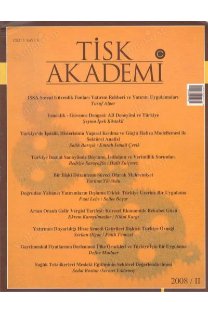Alternatif kriz yaklaşımı: Beyin kazanımı ve teknogirişimcilik
An alternative approach to crisis: Brain gain and technopreneurship
___
- Avrupa Yatırım Fonu (2007), SME Finance, EIB-CSO Workshop Paper.
- http://www.eib.org/attachments/gene-ral/events/brussels_2006051l__Liauzu.pdf
- Brown, M. (2000), Using the Intellectual Diaspora to Reverse Brain Drain: Some Useful Examples, Conference Report, Capetown University.
- www. uneca.org/docs/Conf erence_Re-ports_and_Other_Documents/brain_dra in/word_documents/brown.doc
- Chang, S. (2006), The Global Silicon Valley Home, Lives and Landscapes Within Taiwanese American Trans-Pacific Culture, Stanford University Press.
- Ching-lung, T. (2003), "Taiwan: Significance, Characteristics and Policies on Return Skilled Migration", Robyn Iredalte, Fei Guo, Santi Rozario (Der), Return Migration in the Asia Pacific, Cheltenham, UK: Edward Elgar 112-135.
- D'Costa, Anthony P. (2008), "The International Mobility of Technical Talent: Trends and Development Implications.", Andres Solimano (Der.), The International Mobility of Talent: Types, Causes and Develop- , ment Impacts. Oxford University Press.
- Fourie, MJ, Joubert, R. (1998), Emigration's Influence on South Africa: A Human Capital Theory Approach, South Africa University.
- Gaillard, J., Gaillard A. (1997), "Introduction: The International Mobility of Brain: Exodus or Circulation", Science, Technology and Society, Vol.2.
- Granovetter, M., Swedberg, R (1992), The Sociology of Economic Life, Westview Press: San Francisco.
- Kannankutty, N., Joan B. (2007), "Why Did They Come to the United States: A Profile of Immigrant Scientists and Engineers." Infobrief NSF 07-324. National Science Foundation, Arlington.
- Kim, L. (2000), The Dynamics of Technological Learning in Industrilisation, Tartışma Metinleri Serisi, United Nations University, INTECH.
- Kim S. (2006), Brain Drain, Brain Gain, and Korean Global Brain Network A Critical Literature Survey and Research Agenda.
- www.uwm.edu/~kim/papers/Bra-in%20Drain%20or%20Brain%20Gain.pdf
- Kuznetsov, Y., Charles S. (2008), "Global Mobility of Talent from a Perspective of New Industrial Policy: Open Migration Chains and Diaspora Networks.", Andres Solimano (Der.), The International Mobility of Talent: Types, Causes and Development Impacts. Oxford University Press.
- Leipziger D. M. (2008), "Brain Drain" and the Global Mobility of High-Skilled Talent, No: 123, Prem Notes, World Bank.
- Meyer, J.B. (1997), "Turning Brain Drain into Brain Gain: The Colombian Experience of the Diaspora Option", Science, Technology and Society, Vol.2, No.2.
- Thorn, K., Lauritz B. Holm-Nielson (2008), "International Mobility of Researchers and Scientists: Policy Options for Turning a Drain into a Gain.", Andres Solima-no (Der), The International Mobility of Talent: Types, Causes and Development Impacts: Oxford University Press.
- World Bank (2007), Knowledge Assessment Methodology (KAM) Database.
- Zweig, D., C. S. Fung (2004), Redefining the Brain Drain: China's Diaspora Option, Center on China's Transnational Relations Working Paper No. 1, The Hong Kong University of Science and Technology.
- Zweig ,D.; C. S. Fung; W. Vanhonacker (2006), "Rewards of Technology: Explaining China's Reverse Migration", Journal of International Migration and Integration,Vol. 7, No:4: 449-471.
- http://www.littlespeck.com/content/people/CTrendsPeople-080123.htm
- http ://w w w .koreatimes. co .kr/w w w/ne ws/nation/2008/10/202_3415 .html
- http://www.the-scientist.eom/2008/07/01/s20/l/
- http://www.newsobserver.com/business/story/1414663.html
- http://www.liveinaustralia.com/liaison/2008/dec/sectionl.asp
- http://peoplemove.worldbank.org/en/content/the-financial-crisis-and immigration-policy-how-some-developed-countries-are-coping
- http ://www .bgn.org/bgn/
- http ://w w w .keane wzealand. com/index .html
- http://www.networkworld.com/news/2009/040109-forrester-now-says-09-us.html?hpgl=bn
- http://www.networkworld.com/news/2009/033109-it-spending.html
- http://www.networkworld.com/news/2009/030309-cio-layoffs.html
- http://www.manpower.com.au/documents/2008_Borderless_Workforce_Survey_Natio nal_Results.pdf
- http://www.workpermit.com/news/2009-02-23/australia/australia-to-reduce immigration numbers.htm
- http://africarecruit.com/diasporainscienceandtechnology/index.php
- http://www.dapmalaysia.org/english/2006/jan06AksAks3770.htm
- http://www.bioforesight.biz/resources/PharmAsia+News+-+Reverse+Brain+Drain+12 18 08.pdf
- http://www.migrationinformation.org/Feature/display .cfm?id= 155
- http://www.jpost.com/servlet/Satellite?cid= 12354107045 04&pagename=JPost% 2FJPArtic-le%2FShowFull
- http://www.american.com/archive/2008/july-august-magazine contents/america2019s-ot-her-immigration-crisis
- http://www.bioforesight.biz/resources/PharmAsia+News+-+Reverse+Brain+Drain+12 18- 08.pdf
- http://www.newsobserver.com/business/story/1414663.html
- http://www.newsobserver.com/business/story/1414663.html
- http://www.livemint.com/2009/03/08160655/Slimming-prospects-in-US-resul.html?d= 1
- http://ec.europa.eu/research/iscp/countries/china/cn-doc5.pdf
- http://www.dapmalaysia.org/english/2006/jan06AksAks3770.htm
- http://www.migrationinformation.org
- http://www.technopreneurdevelopment.net.my/cms/AHProduct.asp?CatID=122
- http://www.singapore-business.com/biz_resources_4.htm
- http://indiainvents.blogspot.com/2008/12/government-attracts-returning students.html
- http://www.singapore-business.com/biz_resources_4.htm
- http://www.finfacts.com/irishfinancenews/article_1016205.shtml
- http://www.finfacts.com/irishfinancenews/article_l 016205 .shtml
- ISSN: 1306-6757
- Yayın Aralığı: 2
- Başlangıç: 2006
- Yayıncı: Türkiye Isveren Sendikalari Konfederasyonu
Müşteri saldırganlığı: Yaygınlığı ve aktörleri (bir alan araştırması)
Alternatif kriz yaklaşımı: Beyin kazanımı ve teknogirişimcilik
Türkiye'de sendikalaşma ve verimlilik: Nedensellik analizi
Tükenmişlik ve üretkenlik karşıtı davranışlar arasındaki ilişkinin kavramsal boyutu
Türkiye'de 1981-2000 döneminde sanayi kesiminde enerji tüketiminin ayrıştırılması
A. Hakan ÇERMİKLİ, Harun ÖZTÜRKLER
İşgücü piyasasında illerin işsizlik risklerinin analitik hiyerarşi süreci ile belirlenmesi
